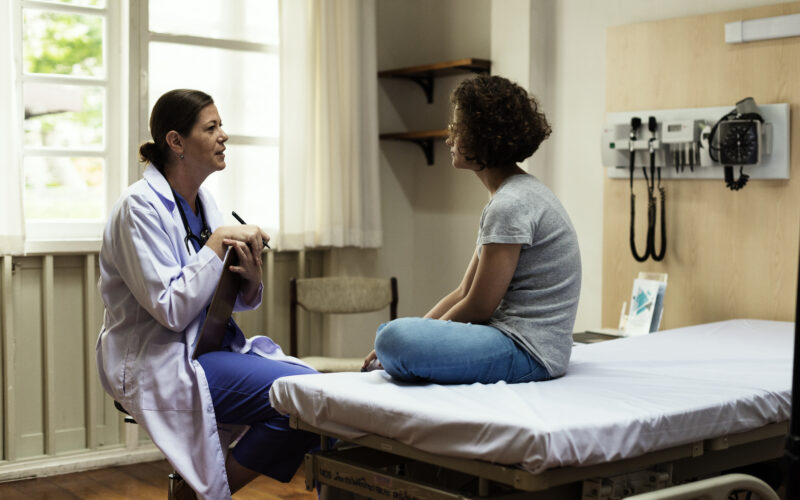If you’ve undergone surgery for endometriosis, you’ve probably wondered “Can endo grow back?” Because there is no actual cure for endometriosis, the answer, unfortunately, is “Yes, it can.” But the more relevant question for most women is: “How likely is my endometriosis to grow back?” The answer to that question is a much more hopeful “It depends.” The bottom line is that many factors are involved in determining your personal risk of disease recurrence after endometriosis surgery, i.e., your risk of endometrial lesions or endometriomas, growing back. However, the type of surgery you had and the skill level of your surgeon are the two most important factors in whether you’ll experience a return of endometriosis and endometriosis symptoms post-surgery.
What factors influence my personal risk of endometriosis recurring?
Depending on the study, recurrence rates can be as low as 6% after endometriosis surgery, or as high as 67%. Why such a discrepancy? For one thing, length of follow-up varies significantly from study to study, and follow-up longer than 5 years is practically nonexistent in mainstream research. A study that follows women for just one year after endometriosis surgery is likely to find lower rates of recurrence than one that tracks women for three or more years post-surgery.
Disease location
Research suggests that the location of your endometriosis plays a role in the likelihood that it will recur. While endometriosis refers generically to any endometrial (uterine lining)-type tissue growing outside the inside of the uterus, endometriomas may be located on other reproductive organs, such as the ovaries or Fallopian tubes, on the bladder, appendix or bowel, between the rectum and the uterus, between the rectum and the vagina, and even on the stomach or lungs. Rates of recurrence may be higher in women with ovarian or peritoneal (lining the abdominal cavity) endometriomas.
Age and disease severity
Recurrence also tends to be higher in younger women, as well as in women who have what’s called deep endometriosis, or deeply infiltrative endometriosis (DIE), meaning that it’s burrowed deep inside an organ or tissue. Women who have endometriosis on both sides of the pelvis also appear to be more likely to experience recurrence.
Hormonal birth control use and risk of recurrence
Several research studies have found that combined hormonal contraceptive (meaning contraceptives like the Pill that contain estrogen and progestin, as opposed to progestin-only contraceptives) use after surgery decreases risk of endometriosis recurrence [1][2][3]. This makes some sense since the Pill stops the woman’s cycle, including menstruation, and endometriosis symptoms tend to be worst during menstruation.
However, there is also evidence that hormonal contraceptive users are more likely to develop endometriosis in the first place. Could hormonal contraception, which comes with its own side effects, be causative in developing endometriosis? Or could it lead to worsening of symptoms if women are put on the Pill for heavy and/or painful periods, delaying actual endometriosis diagnosis (and potentially surgery) for years? On average, 10 years elapse between a woman’s first experience of endometriosis symptoms and her receiving a diagnosis. The unclear role of oral contraception in regards to endometriosis development requires further research.
While these risk factors can influence your personal risk for disease recurrence, ultimately, the most significant factors for recurrence are the type of surgery you have and who performs the surgery.
Which kind of endometriosis surgery did you have? Excision or ablation?
In the words of the Endometriosis Foundation of America, “laparoscopic excision surgery is the gold standard of treatment for endometriosis.” “Laparoscopic” means that rather than cutting the abdomen open “stem to stern,” several small cuts are instead made on the abdomen, just big enough to introduce a small scope with a camera on the end. This allows direct visualization of areas of endometriosis. Excision surgery is surgery that seeks to literally cut out all areas of endometriosis, no matter how deeply embedded they may be. Laparoscopic ablation or cauterization surgery, on the other hand, refers to superficial burning or cautery of visible areas of endometriosis.
As Natural Womanhood previously noted, “Ablation uses heat to destroy tissue, while excision uses heat to actually remove it. Ablation can only remove tissue on the surface, while excision can dig deeper to remove all of it. A 2017 meta-analysis found that excision is a more effective technique—better at reducing dysmenorrhea (period pain), dyschezia (constipation), and chronic pelvic pain—so it’s a good idea to look for a surgeon who does excision rather than ablation [4].”
An article at InTouch Fertility about NaProTECHNOLOGY’s surgical approach offers further explanation into why excision is preferable to ablation. “Endometriosis acts like an iceberg, where the disease is both above the surface and in the tissue below.” For this reason, excision surgery, which “removes the disease both above and below the surface” has the best chance of preventing disease recurrence.
Many research studies have confirmed that ablation surgery does not solve the problem of endometriosis long-term. One 2012 study found that “One year after laser ablation for painful pelvic endometriosis, 29% of women who continued to be symptomatic were found to have progressive disease, and 42% static disease at second look laparoscopy. Many women may undergo additional surgical intervention as a result of persistent or worsening symptoms. The reoperation rate after laparoscopic treatment of endometriosis has been found to be 21% at 2 years, and 58% at 7 years. Endometriosis was most likely to recur close to the original area of involvement, which may be the result of incomplete excision or ablation” [5].
Results of another study were even more stark, finding that recurrence occurred within one to two years in up to 40-60% of women who underwent ablation surgery [6].
The Endometriosis Association of America is unequivocal in its recommendation of excision surgery over ablation surgery. “Ablation or cauterization only remove the tissue on the surface, but neglect the tissue growing beneath the surface. In most cases, ablation/cauterization surgery will not be effective for long-term management of endometriosis, because the tissue remains below the surface. Excess scar tissue can also form using these methods due to the high energy and heat applied to surrounding healthy tissue. In many cases, the inflammation following ablation and cauterization can be another source of pain. We do not recommend ablation/cauterization surgery.”
The Atlanta, Georgia-based Center for Endometriosis Care cites over two dozen studies that confirm the superiority of excision surgery over superficial ablation or cauterization surgery, which can be found here.
Who performed your endometriosis surgery?
Besides the type of surgery you had, another crucial component is who did your surgery. Dr. Thomas Hilgers, founder of NaProTECHNOLOGY, wrote in his book The NaProTECHNOLOGY Revolution that advanced training is absolutely vital for providers who offer excision surgery. He noted that very few doctors receive this level of specialized training, making them more likely to offer the less effective ablation or cauterization option because it is less technically difficult.
Over several decades of research and extensive experience performing laparoscopic excision surgeries for endometriosis, Dr. Hilgers found that “near-contact laparoscopy,” in which the scope is placed right next to the tissues being observed rather than kept at a distance (as in traditional laparoscopy), led to decreased recurrence. He also found that performing laparoscopic excision surgery during the first half of the menstrual cycle led to decreased rates of recurrence. NaProTECHNOLOGY-trained surgical fellows are trained in Dr. Hilgers’ methods, which have led to achievement of a <7% recurrence rate of endometriosis following laparoscopic excision surgery.
I had a hysterectomy along with laparoscopic surgery. How does that impact my risk of recurrence?
Unfortunately, having a hysterectomy for endometriosis, even a hysterectomy plus laparoscopic excision, is no guarantee that endometriosis symptoms will resolve. This is because, according to the Endometriosis Association of America “Most endometriosis is located in areas other than the reproductive organs. If you simply remove the uterus and do not excise the remaining lesions, patients will continue to have pain.” (emphasis added)
Research suggests that the “probability of pain persistence post-hysterectomy ranges around 15% and risk of pain worsening is between 3%-5%” [7].
Signs of endometriosis returning
According to the Endometriosis Association, symptoms consistent with a recurrence of endometrial lesions after surgery include:
- Pain in lower abdomen before and during periods (usually worse than “normal” menstrual cramps)
- Pain during or after sexual activity
- Painful urination/bowel movements during periods
- Fatigue
- Infertility
- Heavy bleeding
- Other gastrointestinal upsets such as diarrhea, constipation, nausea
Infertility, which impacts some 30-40% of women with endometriosis, is another concerning symptom.
Optimal post-operative care
While your risk of endometriosis recurrence has much to do with the type of surgery you undergo and the level of expertise of your surgeon, there are certain things you can do to optimize your overall health. Since endometriosis is suspected to have an immune and/or inflammatory component, many restorative reproductive medicine (RRM) professionals, such as NaPro, FEMM, and other such providers, will recommend women follow an anti-inflammatory diet high in fresh fruits, veggies, nuts, and seeds, and low in processed sugar, alcohol, and caffeine. Indeed, some research suggests that diet may be a modifiable risk factor for developing endometriosis, with an anti-inflammatory diet suspected to play a preventive role.
In her book Fertility, Cycles, and Nutrition, the late Marilyn M. Shannon recommended women with endometriosis take specific nutritional supplements such as flax oil or fish oil, along with a variety of B vitamins, to address the hormonal imbalances that often coexist with endometriosis. The Endometriosis Association’s nutritional recommendations overlap with many of Shannon’s, and also include taking a probiotic to improve gut health since the gut plays a significant role in regulating hormones.
Regular exercise can also improve some endometriosis symptoms. Natural Womanhood previously covered five non-traditional ways to manage the pelvic pain many women with endometriosis experience. Additionally, learning to chart your cycle using a fertility awareness method (FAM) can be a helpful tool in gaining body literacy for improved self-advocacy and in providing a basis for evaluation of hormonal imbalances by a trained RRM professional.
References:
[1] Grandi, Giovanni et al. “Hormonal contraception in women with endometriosis: a systematic review.” The European journal of contraception & reproductive health care : the official journal of the European Society of Contraception vol. 24,1 (2019): 61-70. doi:10.1080/13625187.2018.1550576 [2] Seracchioli, Renato et al. “Long-term cyclic and continuous oral contraceptive therapy and endometrioma recurrence: a randomized controlled trial.” Fertility and sterility vol. 93,1 (2010): 52-6. doi:10.1016/j.fertnstert.2008.09.052 [3] Bozdag G. Recurrence of Endometriosis: Risk Factors, Mechanisms and Biomarkers. Women’s Health. 2015;11(5):693-699. doi:10.2217/whe.15.56 [4] Pundir, Jyotsna et al. “Laparoscopic Excision Versus Ablation for Endometriosis-associated Pain: An Updated Systematic Review and Meta-analysis.” Journal of minimally invasive gynecology vol. 24,5 (2017): 747-756. doi:10.1016/j.jmig.2017.04.008 [5] Giudice, Linda, Johannes Evers, DL Healy. Endometriosis: Science and Practice. Chichester, West Sussex: Wiley-Blackwell, 2012 (Print) [6] Yeung P Jr, Sinervo K, Winer W, Albee RB Jr. Complete laparoscopic excision of endometriosis in teenagers: is postoperative hormonal suppression necessary? Fertil Steril. 2011 May;95(6):1909-12, 1912.e1 [7] Berlanda N, Vercellini P, Fedele L. The outcomes of repeat surgery for recurrent symptomatic endometriosis. Curr Opin Obstet Gynecol. 2010;22(4):320-325.Additional Reading:
If you’re considering a hysterectomy for endometriosis, read this first
“What causes endometriosis?” and other questions: A Natural Womanhood Endo FAQ
Considering endometriosis surgery? Here’s how to find a good endo surgeon
5 Non-surgical, Non-Pharmaceutical Approaches to Treating Pelvic Pain







